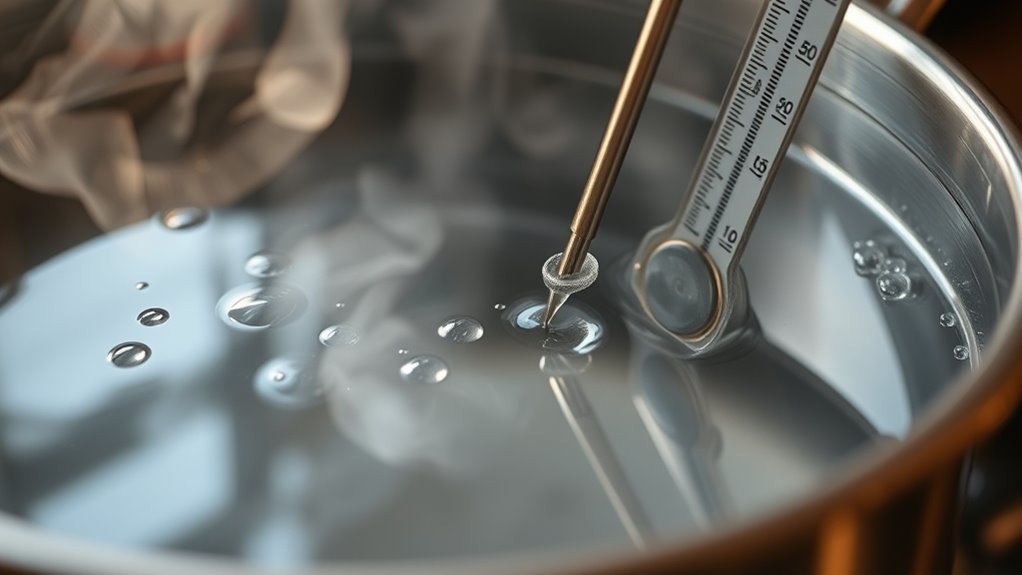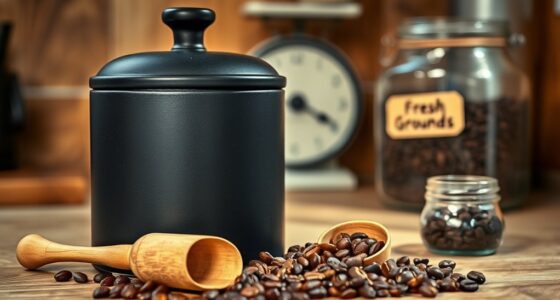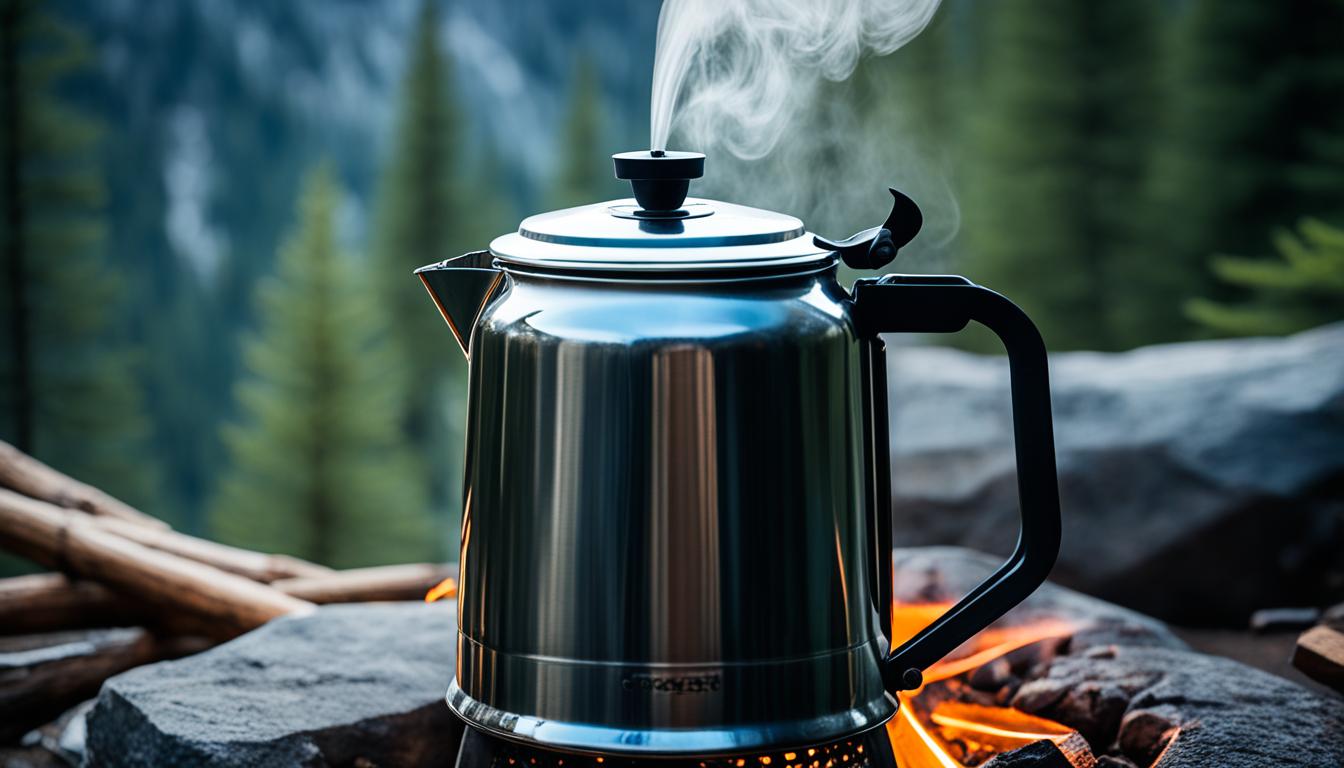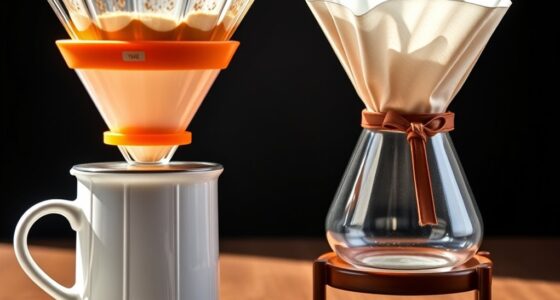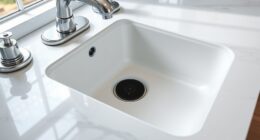To find the ideal water temperature for brewing, aim for a mash range of 148–152°F (64–67°C), where enzymes work most effectively to convert starches into sugars. Use reliable thermometers to guarantee precise control and maintain consistent temperatures throughout the process. Proper temperature management helps achieve the ideal flavor, body, and alcohol content in your beer. Keep exploring these tips to master temperature control and enhance your brewing success.
Key Takeaways
- Maintain mash water temperature between 148-152°F (64-67°C) for balanced enzyme activity and optimal sugar extraction.
- Use a reliable thermometer and temperature control devices to monitor and stabilize water temperature during brewing.
- Proper insulation of mash tun helps prevent temperature fluctuations and ensures consistent results.
- Adjust water temperature based on desired beer profile, such as fuller, drier, or sweeter flavors.
- Small temperature variations significantly impact enzyme efficiency and final beer quality; precise control is essential.

Have you ever wondered how water temperature affects your brewing process? It’s a critical factor that can make or break your final product. When you’re brewing, especially during the mashing stage, controlling the mash temperature is essential. The mash temperature determines how enzymes break down starches into fermentable sugars, directly influencing the beer’s body, flavor, and alcohol content. If the temperature is too low, enzymes won’t work efficiently, leading to poor extraction of sugars and a thin, underdeveloped beer. On the other hand, if it’s too high, you risk over-extraction, which can produce undesirable flavors and a thicker, more residual sweetness. Finding that sweet spot is key to achieving ideal extraction efficiency, where you maximize the conversion of starches into fermentable sugars without extracting unwanted compounds.
Maintaining the correct mash temperature ensures you get the most out of your grains. For example, a mash around 148-152°F (64-67°C) typically fosters a balance between fermentable sugars and body, resulting in a clean, smooth beer. If you want a fuller mouthfeel or sweeter profile, slightly higher temperatures—around 154-158°F (68-70°C)—are preferable. Conversely, lower temperatures tend to produce a drier, more highly fermentable wort. It’s essential to use a reliable thermometer and monitor closely, as even small temperature fluctuations can influence extraction efficiency. The use of temperature control devices can help maintain consistent mash temperatures and improve overall brewing results. The goal is to keep the mash temperature stable throughout the process, which can be achieved with proper insulation or temperature control devices. Additionally, understanding the butter making process can inspire you to incorporate dairy elements or create unique flavor profiles in your brewing.
Adjusting mash temperature isn’t just about flavor; it also impacts the efficiency of your extraction process. When you hit the right mash temperature, you facilitate enzyme activity that breaks down complex carbohydrates efficiently, releasing fermentable sugars and other soluble compounds. This means you get the most out of your grain bill, reducing waste and ensuring your yeast has enough nutrients for healthy fermentation. If your mash gets too hot or too cold, enzyme activity drops, and you may end up with a less efficient extraction, resulting in a weaker beer or one that’s overly sweet or dull. Achieving the ideal mash temperature requires attention to detail, patience, and a good understanding of your ingredients.
Ultimately, controlling water temperature during the mash isn’t just a technical detail; it’s the foundation of a successful brew. By paying close attention to mash temperature, you optimize extraction efficiency, ensuring your beer develops the desired flavors, body, and alcohol content. It’s a balancing act—one that rewards you with a better brew when done right. So, take the time to measure, adjust, and maintain the right temperature, and watch your brewing process become more consistent and your beer more exceptional.
Frequently Asked Questions
How Does Water Temperature Affect Fermentation Speed?
Water temperature directly impacts fermentation speed because it influences yeast activity. When you maintain the right temperature, yeast becomes more active, speeding up fermentation and producing desired byproducts efficiently. If the temperature’s too high, yeast may become stressed, leading to off-flavors and sluggish activity. Conversely, too low slows yeast action, delaying fermentation. Balancing water temperature ensures ideal yeast activity and consistent fermentation byproducts, resulting in better brew quality.
What Is the Ideal Water Temperature for Different Beer Styles?
Think of brewing like tuning an instrument; the right temperature sets the perfect tone. For different beer styles, you’ll want specific water temps during the grain mash to optimize starch conversion and yeast activation. Light beers like pilsners thrive around 148-152°F, while darker ales need 154-158°F. Maintaining these temps guarantees your yeast activates properly and your beer develops its ideal flavor profile.
How Can I Accurately Measure Water Temperature During Brewing?
To accurately measure water temperature during brewing, you should use a reliable thermometer and make sure it’s properly calibrated. Regularly check and calibrate your thermometer to maintain accuracy. Stir the water gently to promote water temperature stability, preventing hot or cold spots. Keep the thermometer immersed at the correct depth, and monitor consistently throughout the process. This way, you’ll get precise readings, helping you control your brewing conditions effectively.
Does Water Temperature Impact the Clarity of the Final Brew?
Yes, water temperature impacts the clarity of your brew. When you control the temperature, you promote clarity enhancement by reducing proteins and tannins that cause haze. Proper temperature also helps sediment settling, allowing unwanted particles to sink more effectively. If the water is too hot or too cold, these processes are hindered, resulting in a less clear final product. So, maintaining the right temperature is key for a crystal-clear brew.
Can Adjusting Water Temperature Improve Hop Extraction?
Imagine opening hidden flavors—adjusting water temperature directly affects hop extraction. You increase water temperature, boosting water solubility, which allows more hop compounds to dissolve, intensifying hop bitterness. Conversely, cooler water limits solubility, resulting in a smoother, less bitter brew. By fine-tuning temperature, you control hop bitterness, enhancing flavor balance. So, yes, adjusting water temperature can greatly improve hop extraction, shaping the character and depth of your final brew.
Conclusion
Remember, just like a delicate garden needs the right amount of water to flourish, your brew thrives at the perfect temperature. I once watched a homebrewer adjust her water temp, and suddenly, her beer transformed—smooth, flavorful, and inviting. Water temperature isn’t just a number; it’s the secret to revealing your brew’s full potential. Keep experimenting, trust your instincts, and soon you’ll see your craft blossom just like that garden in full bloom.
